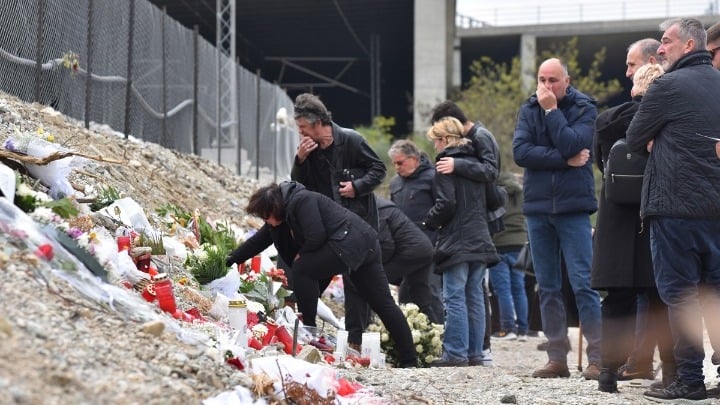
The Greek railways safety issue surfaced once again when a suburban train in Athens ran a red light on Saturday, putting hundreds of passengers in danger a year after the Tempe disaster.
In addition to Saturday’s near miss, railway authorities have encountered 567 train malfunctions in the past eleven months. Furthermore, dozens of train crossings across Greece remain unguarded, adding to the problems faced by the two main railway operators.
The Hellenic Trains Organization (OSE) and Hellenic Train SA, the private company that operates passenger and freight trains in Greece, are marred by continuous incidents that have thousands of passengers doubting the safety of railway travel in the country.
A few days prior to Saturday’s incident, local media in Larissa showed security camera images accompanied by a deafening noise and a flash when a train passed by the area of Karagatsi Street in Larissa. The incident is being investigated.
Α video posted on YouTube two weeks ago on the one-year anniversary of the tragic collision at Tempe shows a freight train stopping at a crossing while the driver opens the cabin door to see if there are cars approaching.
So far, OSE and Hellenic Train seem to be failing to agree on a strategy to make Greek railways safe for travel. The pertinent Ministry of Infrastructure and Transport appears to have failed to impose order on the Greek railway system as well.
Meanwhile, the relationship between state-owned OSE and Italian-owned Hellenic Train seems to be rocky. It is a problem that became evident in the aftermath of the Tempe railway disaster. The two sides do not assume any responsibility regarding the accident.
On Monday, in a meeting between the Ministry of Infrastructure and Transport and all agencies and organizations involved, political authorities requested that OSE and Hellenic Train commit to continuous and close cooperation in all issues related to railway safety and strict compliance with the General Traffic Regulation throughout the Greek railway network.
EU investigation in a tangle
The ongoing investigation by the European Public Prosecutor’s Office (EPPO) on the Tempe tragedy shows that the issue of Greek railway safety is in a twenty-year tangle, showing Greece’s insufficient investment planning and the European Commission’s lax monitoring mechanisms.
Two key projects, namely the installation of the European Train Control System (ETCS) and the upgrade of the communication and signaling system on trains, both meant to ensure railway safety, have not been implemented.
The first project should have been completed in the 2000 to 2006 period while the second was to have been completed between 2000 and 2013. Both projects were based on digital technology in order to avoid human error, such as was the case with the Tempe disaster that cost the nation fifty-seven lives.
Neither has been completed, even though the European Commission had been pressuring for their implementation for years.
In 2014, a new contract was signed under a New Democracy/PASOK government, the 717/2014 contract for the upgrade of the signaling system on Greek trains and remote control operation. The project was supposed to have been completed by 2016.
It included the construction of fifty-two stations and three remote control centers for the Greek railway system from Athens to Thessaloniki and Promachonas. Remote control is critical because without the ETCS control system, which automatically brakes trains if they exceed a set speed or detect a serious problem, it cannot function.
However, the contract had technical ambiguities and loopholes and stalled. In January 2015, Greece had a new government, the leftist SYRIZA, and the signing of a new MoU for Greece’s bailout. The stalled project went to the court of auditors.
According to Euractiv, the court ruled in 2018 that a supplementary contract was needed, raising the costs by €13.3 million while the initial amount was €42 million. SYRIZA claims it delivered a contract without any legal hurdles and the project was seventy percent complete.
The European Commission pushes for railway project completion
The supplementary contract was ready in 2018, but in the 2019 national election, the New Democracy party came to power and did not sign the contract until 2021.
In June 2021, the European Commission sent a letter to the Greek government explicitly saying that the two projects had been co-financed by the EU but were never implemented. There was also a warning that Greece would be subject to a “financial correction” of almost €18 million.
The Greek government reacted, saying that efforts are made for the projects to be finalized and that the “financial correction” amount was unjust considering the amounts of national resources invested in the two projects. The European Commission was not convinced and asked for a hearing so that the Greek government could explain the delays.
Athens claims the project is in the execution process. The end date for expenditure eligibility for the EU co-funded projects implemented under the 2014 to 2020 programming period was December 31, 2023.
The Greek railway disaster brought to the surface the 717/2014 contract that was never implemented. EPPO is currently investigating the contract to determine if there are financial damages to EU interests.
See all the latest news from Greece and the world at Greekreporter.com. Contact our newsroom to report an update or send your story, photos and videos. Follow GR on Google News and subscribe here to our daily email!



